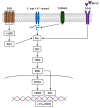The Role of CaMKII and ERK Signaling in Addiction
- PMID: 33804804
- PMCID: PMC8004038
- DOI: 10.3390/ijms22063189
The Role of CaMKII and ERK Signaling in Addiction
Abstract
Nicotine is the predominant addictive compound of tobacco and causes the acquisition of dependence through its interactions with nicotinic acetylcholine receptors and various neurotransmitter releases in the central nervous system. The Ca2+/calmodulin-dependent protein kinase II (CaMKII) and extracellular signal-regulated kinase (ERK) play a pivotal role in synaptic plasticity in the hippocampus. CaMKII is involved in long-term potentiation induction, which underlies the consolidation of learning and memory; however, the roles of CaMKII in nicotine and other psychostimulant-induced addiction still require further investigation. This article reviews the molecular mechanisms and crucial roles of CaMKII and ERK in nicotine and other stimulant drug-induced addiction. We also discuss dopamine (DA) receptor signaling involved in nicotine-induced addiction in the brain reward circuitry. In the last section, we introduce the association of polyunsaturated fatty acids and cellular chaperones of fatty acid-binding protein 3 in the context of nicotine-induced addiction in the mouse nucleus accumbens and provide a novel target for the treatment of drug abuse affecting dopaminergic systems.
Keywords: Ca2+/calmodulin-dependent protein kinase II; dopamine D1 receptor; dopamine D2 receptor; extracellular signal-regulated kinase; fatty acid-binding protein 3; nicotine-induced addiction.
Conflict of interest statement
The authors declare no conflict of interest.
Figures



Similar articles
-
Impaired Acquisition of Nicotine-Induced Conditioned Place Preference in Fatty Acid-Binding Protein 3 Null Mice.Mol Neurobiol. 2021 May;58(5):2030-2045. doi: 10.1007/s12035-020-02228-2. Epub 2021 Jan 7. Mol Neurobiol. 2021. PMID: 33411237
-
Amelioration of Nicotine-Induced Conditioned Place Preference Behaviors in Mice by an FABP3 Inhibitor.Int J Mol Sci. 2023 Apr 2;24(7):6644. doi: 10.3390/ijms24076644. Int J Mol Sci. 2023. PMID: 37047614 Free PMC article.
-
Nicotine-induced phosphorylation of ERK in mouse primary cortical neurons: evidence for involvement of glutamatergic signaling and CaMKII.J Neurochem. 2007 Oct;103(2):666-78. doi: 10.1111/j.1471-4159.2007.04799.x. Epub 2007 Jul 31. J Neurochem. 2007. PMID: 17666046
-
Effects of nicotine on DARPP-32 and CaMKII signaling relevant to addiction.Adv Pharmacol. 2021;90:89-115. doi: 10.1016/bs.apha.2020.09.002. Epub 2020 Oct 6. Adv Pharmacol. 2021. PMID: 33706940 Free PMC article. Review.
-
Dopamine D₁-D₂ receptor heteromer regulates signaling cascades involved in addiction: potential relevance to adolescent drug susceptibility.Dev Neurosci. 2014;36(3-4):287-96. doi: 10.1159/000360158. Epub 2014 May 8. Dev Neurosci. 2014. PMID: 24820626 Review.
Cited by
-
Synergistic Anticancer Effect of a Combination of Berbamine and Arcyriaflavin A against Glioblastoma Stem-like Cells.Molecules. 2022 Nov 17;27(22):7968. doi: 10.3390/molecules27227968. Molecules. 2022. PMID: 36432068 Free PMC article.
-
Radiosynthesis, Preclinical, and Clinical Positron Emission Tomography Studies of Carbon-11 Labeled Endogenous and Natural Exogenous Compounds.Chem Rev. 2023 Jan 11;123(1):105-229. doi: 10.1021/acs.chemrev.2c00398. Epub 2022 Nov 18. Chem Rev. 2023. PMID: 36399832 Free PMC article. Review.
-
Natural L-type calcium channels antagonists from Chinese medicine.Chin Med. 2024 May 21;19(1):72. doi: 10.1186/s13020-024-00944-8. Chin Med. 2024. PMID: 38773596 Free PMC article.
-
Extracellular signal-regulated kinase in the basolateral amygdala is required for reconsolidation of heroin-associated memory.Front Mol Neurosci. 2022 Nov 10;15:1020098. doi: 10.3389/fnmol.2022.1020098. eCollection 2022. Front Mol Neurosci. 2022. PMID: 36438183 Free PMC article.
-
Effects of Apamin on MPP+-Induced Calcium Overload and Neurotoxicity by Targeting CaMKII/ERK/p65/STAT3 Signaling Pathways in Dopaminergic Neuronal Cells.Int J Mol Sci. 2022 Dec 3;23(23):15255. doi: 10.3390/ijms232315255. Int J Mol Sci. 2022. PMID: 36499581 Free PMC article.
References
-
- Forouzanfar M.H., Afshin A., Alexander L.T., Anderson H.R., Bhutta Z.A., Biryukov S., Brauer M., Burnett R., Cercy K., Charlson F.J., et al. Global, regional, and national comparative risk assessment of 79 behavioural, environmental and occupational, and metabolic risks or clusters of risks, 1990–2015: A systematic analysis for the Global Burden of Disease Study 2015. Lancet. 2016;388:1659–1724. doi: 10.1016/S0140-6736(16)31679-8. - DOI - PMC - PubMed
-
- Reitsma M.B., Fullman N., Ng M., Salama J.S., Abajobir A., Abate K.H., Abbafati C., Abera S.F., Abraham B., Abyu G.Y., et al. Smoking prevalence and attributable disease burden in 195 countries and territories, 1990–2015: A systematic analysis from the Global Burden of Disease Study 2015. Lancet. 2017;389:1885–1906. doi: 10.1016/S0140-6736(17)30819-X. - DOI - PMC - PubMed
Publication types
MeSH terms
Substances
LinkOut - more resources
Full Text Sources
Other Literature Sources
Miscellaneous

